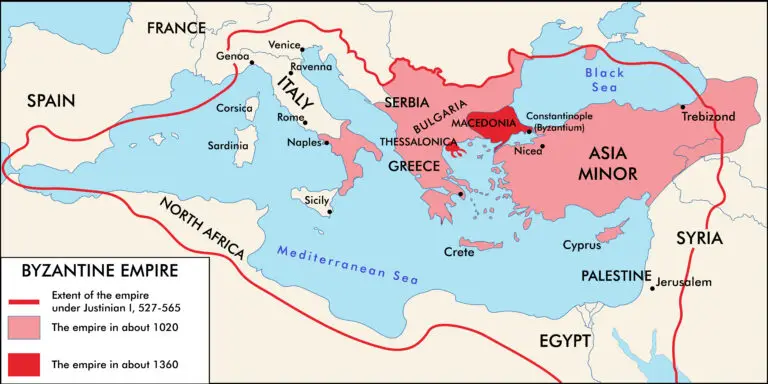Byzantine Empire

Table of Contents
What was the Byzantine Empire?
The Byzantine Empire, often considered the eastern continuation of the Roman Empire, was a medieval state centered around the capital city of Constantinople (modern-day Istanbul) that endured for over a thousand years. Its foundation is traditionally dated to 330 AD when Emperor Constantine the Great established Constantinople as the new capital of the Roman Empire.
This empire reached its zenith under Emperor Justinian I (527-565 AD), who sought to reclaim the territories of the Western Roman Empire and codify Roman law in the Corpus Juris Civilis.
Despite facing various external threats, such as invasions by the Huns, Persians, and later the Arab Muslims, the Byzantines managed to preserve their civilization, adapting and blending Roman, Greek, and Christian traditions.
Byzantine Empire History
The Byzantine Empire, also known as the Eastern Roman Empire, continued the Roman Empire and existed from 330 AD to 1453 AD.
Constantine the Great, the Roman Emperor, established the Byzantine capital of Constantinople (modern-day Istanbul) in 330 AD, which became a significant center of commerce, culture, and political power.
The official language of the Byzantines was Greek, and Roman traditions deeply influenced its legal system and administration.
Justinian I, who ruled from 527 to 565 AD, was a notable Byzantine emperor known for his extensive legal reforms, including the compilation of Roman laws in the Corpus Juris Civilis.
The Hagia Sophia, built during the reign of Emperor Justinian I, is one of the most famous examples of Byzantine architecture, serving as an Eastern Orthodox cathedral, an imperial mosque, and now a museum.
The empire faced multiple external threats, including invasions by the Persian Sassanian Empire and later conflicts with various Islamic Caliphates, notably during the Arab-Byzantine Wars.
Iconoclasm, a theological debate over the use of religious images, divided the Byzantine Empire during the 8th and 9th centuries, destroying many religious artworks.
The empire played a crucial role in preserving and transmitting classical Greek and Roman knowledge to the medieval Western world, especially during the period known as the Byzantine Renaissance.
The Great Schism of 1054 resulted in the split between the Roman Catholic Church in the West and the Eastern Orthodox Church in the Byzantine East, marking the formal separation of the two Christian traditions.
The Fourth Crusade (1202-1204) resulted in the sack of Constantinople by Western Christian forces, causing significant damage to the Byzantine Empire and contributing to its decline.
Related Links
The Crusades
Ottoman Empire
Bourbon Dynasty
Hapsburg Dynasty